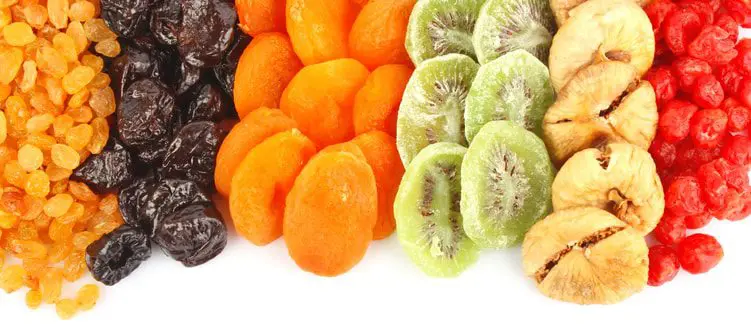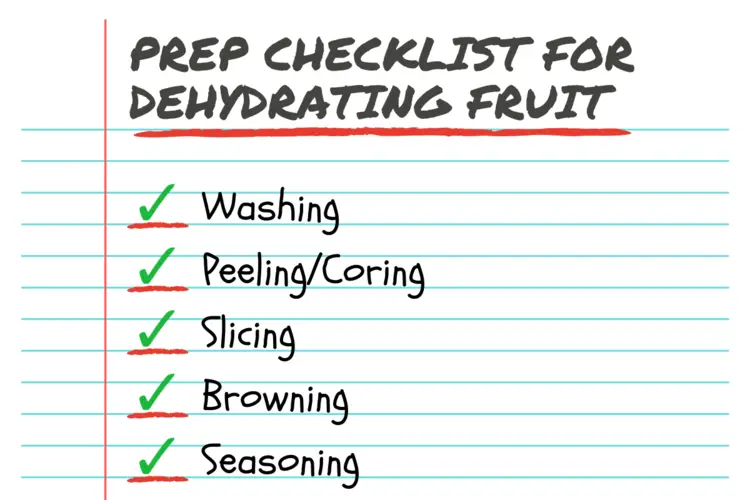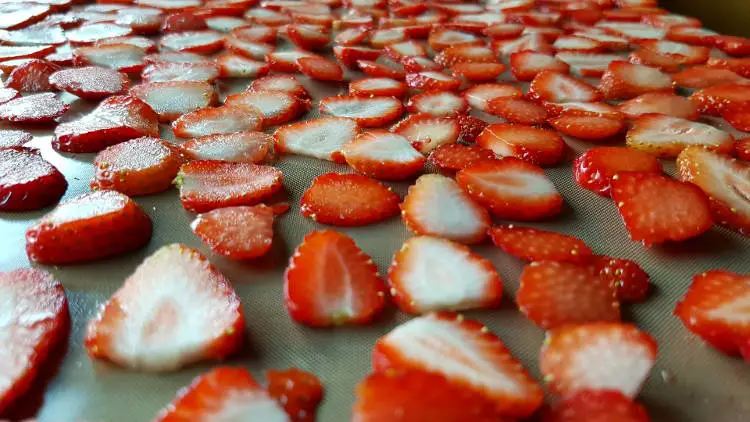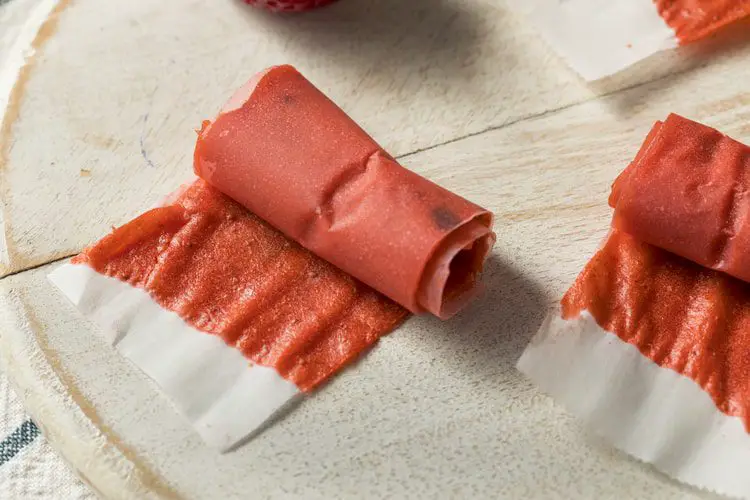Dehydrating food sounds like something that would happen in a lab. It’s like some process we would use to make food for astronauts.
In fact, knowing how to dehydrate fruit is a skill that we have been utilizing to preserve food since at least the Ice Age.
Dehydrated food is not just something to bring for camping. Dehydrated fruit can take the place of those unhealthy snacks in your life.
You might be wondering, “Is dehydrated fruit healthy?” With our overwhelming concern about sugar in the modern age, it’s understandable.
What most people get wrong about eating fruit is that there is fiber to counteract the sugar. That makes all the difference. Eating dehydrated fruit is healthy, and it’s a much better option than the processed foods in our grocery stores.
Once you know how to dehydrate food in the oven, you can take advantage of the health benefits of dehydrated fruit.
There are a number of different ways that you can dehydrate fruit. You can even dehydrate fruit with an air fryer. That is a pretty cool little hack.
Dehydrated foods are also great in recipes. This is a lost art, and it’s one that the supermarkets are trying to replace with empty calories and highly processed foods.
This stuff is cheap to produce, and it sits on shelves for a long time. Now is the time to start drying fruit on a regular basis.
Choosing a Dehydrator

A dehydrator is essential if you are going to be dehydrating food on a regular basis. You will be able to dehydrate most things at the drop of a hat.
You don’t have to leave your oven on overnight or anything like that. If you are reading this article, chances are you already own a dehydrator or are looking for the right one for you.
Whether you are in the market for the best food dehydrator for fruit or jerky, the model is out there.
Basic Components of a Food Dehydrator
Most food dehydrators operate the same way. It’s the details and the features that make a model stand out.
Airflow
The basic food dehydrator function is airflow. Consistent airflow from some type of built-in fan or fan system.
There is also the role of heat in the function of these dehydrators. The airflow and heat sap the moisture from the food slowly, creating a dehydrated snack.
Now, as I mentioned, the devil is in the details. Just because you know how to dehydrate fruit doesn’t mean you have all the tools to do it best.
Thermostats
Some types of food dehydrators operate on a controllable thermostat.
This is a feature of a good dehydrator for fruit. Your ability to control temperature goes a long way.
Tray Size
The size and quantity of the trays are going to dictate efficiency with your unit. It would seem like the more space you have, the better. However, you might not always be dehydrating that much food.
Seek out the tray system that works best for you. Some trays are also going to be dishwasher-safe. That is a great convenience.
Digital Controls
Dehydrators are like anything else; there are value models that come with your basic off switch, and then there are premium models that come with fully digital controls that affect many parts of the dehydrating process.
These models are undoubtedly worth a look. Of course, you are going to have to pay more for all of these features.
The best dehydrator for you is going to be the one that meets your needs. Dehydrating food is a great means of food preservation.
What are you looking to get out of dehydrating your food?
Though you might know how to dehydrate fruit until you get a few sessions under your belt, you may not yet understand all the benefits.
Tips for Successfully Dehydrating Fruit

Let’s go over a few methods for starting off on the right foot. There are many things to consider when it comes to starting a dehydration project.
Browning
Some foods are going to brown when you cut them. We have all seen this happen with apples. It’s just part of the deal. Other fruits, like peaches, apricots, and pears, will turn as well.
If you plan on dehydrating these, you are going to need to invest in a lemon juice and water mixture. Use a 4:1 ratio of water to juice for the best results.
Dip each piece of cut fruit into a bowl with your lemon water mixture, and then lay that piece of fruit out to dry. These can go from the mixture right to your trays for dehydrating.
Quality of Food
The quality of your food will determine a lot about what you can do with your dehydration process. Fresh food is essential, but overripe fruits can be a little problematic. Obviously, rotting food is not something that you want to dehydrate.
Homegrown food picked at its peak is going to have the best flavor, but you could also pick some things a little underripe, so these fruits are easier to process. Things like peaches and strawberries are great examples.
Obviously, those with home gardens are going to benefit most from having a food dehydrator and knowing how to dehydrate fruit.
Thickness
The more moisture a fruit contains, the more you are going to have to consider its thickness. How thickly you cut your fruit will determine the end result.
A great example is bananas. You can slice bananas very thinly, and you will end up with something like a crispy banana chip.
Alternatively, slice them around 2 inches thick, and you get a delicious dehydrated banana “coin” that is the perfect healthy snack!
A lot of it comes down to personal preference. You will find out what you like most about dehydrated fruit. If texture is important to you, you might prefer thicker-cut fruit.
A good size to cut most fruits is going to be 1/2 an inch. There are also small fruits, like raspberries and blueberries, that will not be cut at all.
Prep Checklist for Dehydrating Fruit

The evaluation and preparation stage of the fruit dehydration process is a key step. Understanding what a fruit needs to be ready for the dehydration process can make everything much easier.
So go ahead and take the time to inspect and prep your fruit before starting the actual dehydration.
Washing
Everything we bring into our homes should be washed to some degree or another. If it’s not growing in your yard, you need to really wash it.
Most contamination and food recall outbreaks originate in the fields where people are picking the food.
Peeling/Coring
After your fruit is washed, the time to think is at hand. What needs to be done to this fruit to best be able to cut it? Is there a peel that should be removed?
When you are cutting fruits, you will not want to slice a round object. It can roll, and you can cut yourself. Create a flat side by slicing down the middle.
This might require that you remove the core or seeds from certain fruits.
Slicing
To begin safely slicing fruits, you should slice a small portion off the side of the fruit, or you should cut the fruit in half. As mentioned above, the idea is to have a flat side that keeps the fruit from rolling.
Again, a good guideline is to cut into a half-inch. That can go a long way with most fruits.
Browning
Now you need to consider browning. Will the fruit turn red if left out in the air to oxidize? If so, use the lemon mixture we discussed above.
Seasoning
Some fruits are great with a little seasoning. Apples are naturally great with a little cinnamon sugar. You might want to add your favorite seasoning to taste.
From here, you are ready to fill your trays and get the dehydration process going.
My Favorite Fruits to Dehydrate
Here is a breakdown of some of my favorite fruits to toss into the dehydrator.
Apples
Dehydrated apples are absolutely delicious. Apple chips are a great alternative to unhealthy snacking. These fruits are great to dehydrate.
Apples are packed with healthy nutrition and fiber. Put simply, they are great for daily intake to improve your overall health.
Because of hybridization, there are few places in this nation where you can grow your own apples. There are few things more rewarding than growing your own apples, harvesting them, and storing them long-term in a dehydrator.
Apples should be washed, peeled, and cored before slicing. They will also need to be protected against browning.
Apples can be dehydrated in the oven, in a dehydrator, or even in the sun. You can string them up outside, and the sun and wind will do the job over about 5 days’ time.
These apple crisps or apple slices are great for long term food storage.
Bananas

The big difference between apples and bananas is that you are not going to grow bananas in your backyard. We all have access to apple trees and could even have some success in apple growing.
Bananas are a tropical fruit, and they are nearly impossible to grow in the United States.
This is all the better when it comes to dehydrating bananas. You want to have access to these if something were to happen with the price, supply chain, or something else.
Bananas contain bioactive compounds and antioxidant properties that protect our bodies and add to our health and well-being.
The powerful potassium and fiber content of bananas offers a host of health benefits. It’s the reason bananas are some of the most popular fruits in the nation.
Bananas are a very simple fruit to process for dehydrating. They are easy to peel and very simple to slice down into 1-inch pieces for dehydrating. They lay on the trays nice and easy, and they do not stick either.
When they are thoroughly dehydrated, bananas are great for long-term food storage. There is a reason why you find tons of great granola recipes with dry bananas in them.
Add mylar bags and oxygen absorbers to the equation. This will drastically increase the amount of storage time you will get.
Blueberries

Blueberries are part of that dark red fruit and vegetable class. When you see dark red fruits, you know that these foods are packed with nutrition.
Blueberries are just the same. They are dense with antioxidants and contain anti-inflammatory properties that help with the prevention of inflammation disorders, cardiovascular diseases, or protective effects to lower the risk of various cancers.
And they’re delicious; even your kids love them! Knowing how to dehydrate blueberries is not only a highly useful preparedness skill, it’s a gift in the kitchen when it comes to your kids.
Of course, blueberries are very expensive. If you grow them, it means you are going to need to do something with these blueberries before they go bad. The very best move is to dehydrate them. They shrink down into little, sweet balls of goodness.
Blueberries are one of the more simple fruits to dehydrate because they do not need to be processed at all. You should wash them, but aside from that, they will go straight into the dehydrator.
Dehydrating blueberries is a very interesting process from a time standpoint because you are going to need to check the larger berries by slicing them in half after dehydration to assure they are dehydrated completely.
Dehydrated blueberries are a great fruit for long-term storage. They are little morsels.
You can package them by themselves, or you can store them long-term with other foods like oats, sugar, and cinnamon for a fantastic prepackaged, long-term food storage meal.
Strawberries

Strawberries are basically the gift of spring. They are the ruby-red sign that summer is on its way. To love dehydrated strawberries is to fully appreciate the taste of one of the best fruits on the planet.
The natural sugars make for a great means of staying energized, regulating blood sugar, and just enjoying a sweet treat. They are also packed with antioxidants, vitamins, and minerals that provide enormous health benefits.
Don’t forget that strawberries are perennial plants. This means they are going to come back year after year, and that is a big deal. Your survival or prepper garden should have a good number of perennials. Make it easy on yourself.
A cheap, covered greenhouse can be a great place to grow strawberries and keep them protected.
You want to slice strawberries to get them dehydrated. They are a very moist fruit and will require a slice. Cut them into 1/4-inch slices and dehydrate for 8–10 hours. What you come up with will be something very special.
These are also great to store long-term. You are going to be able to pack these up like any other long-term food storage and get 20 years out of them!
Tomatoes

Tomatoes are another one of those red beauties. Red is a great color when you are considering a diet. As long as we aren’t talking red dye!
Dehydrated tomatoes are rich in nutrition, which is a great reason to add them to your food storage plan.
With powerful compounds like lycopene, the tomato has been eaten by very healthy populations for a long time. The men of Crete live on a diet of fish, tomatoes, red wine, and olive oil. These men work into their 80s!
Most backyard gardeners grow tomatoes to one degree or another. You see people who are absolutely sick about tomatoes by July.
It can be overwhelming if you have a good harvest. Tomatoes need lots of sun, deep watering, and something to scale. They like growing upward.
One ingredient that dehydrates just as much in the sun, ovens, and dehydrators is tomatoes. They are meaty and dry well in all of those environments.
The difference is going to be time. You see, sun-dried tomatoes will take 3-5 days to dry out completely. A dehydrator can get it done in 10–12 hours. So the choice is yours.
The flavor depth of sun-dried tomatoes stored in oil is very distinctive and is not possible to achieve when drying tomatoes in a dehydrator.
Because of the massive harvest and your ability to use tomatoes in so many recipes, storing them for the long term makes a lot of sense.
You can store dehydrated tomatoes in ball jars or mason jars. Sun-dried tomatoes should be stored in oil in a similar jar. However, you can also store them for the long term in mylar bags with oxygen absorbers.
Making Dehydrated Fruit Leather

Another great way to enjoy dehydrated fruit is to learn about dehydrating fruit leather.
This is an essential part of learning how to dehydrate fruit. Fruit leather can be a combination of fruits, and that can get pretty exciting if you enjoy a mix of flavors.
Dehydrated fruit Leather is basically a puree of one fruit or a mix of fruits that is spread out and dehydrated. This process can also be done in a 200-degree oven.
Fruit leather can be rolled up and stored. It is great in kids’ lunches.
How to Store Dehydrated Fruit

There are many ways to store fruit once you know how to dehydrate it.
Once you understand how to dehydrate fruit, your world is open to all kinds of possibilities. Add it to recipes or store it for the long term.
The question you might be asking yourself is: How long does dehydrated fruit last?
This has a lot to do with how you decide to store your dry fruit. There are many different means of storing food for the short and long term. Most people count on plastic bags and refrigeration nowadays.
We will look at several ways that can be used to dehydrate fruit and store it. We are going to look at the methods that will be best for the short-term and long-term options.
One thing is for certain: if you want to store your dehydrated fruit for the long term—I mean, 20+ years—it’s possible. It doesn’t take a lot of complicated or expensive materials to make this happen.
Short-Term Methods for Storing Dehydrated Fruit
These short-term storage methods for dehydrated fruit are going to get you up to a year of quality storage for your dehydrated fruits. Knowing how to store your fruit is as important as knowing how to dehydrate it.
Ziploc Bags
Good ol’ Ziploc bags are actually a great method for storing your dehydrated fruit.
You can purchase the larger bags and store the fruit inside them. Alternatively, you can break your batch down into many smaller Ziplocs that are great to throw in bags, lunch boxes, or just grab while you sit around the house.
Ziploc storage is going to get you about a year before things start to get squirrely.
You might see certain fruits start to break up from being jostled and moved around. Likewise, you might experience some increased texture in your fruit from naturally occurring moisture in the air.
Tupperware
Tupperware containers are another great way to store your dehydrated fruits.
They will not be as airtight as your Ziplocs, but they will provide a lot more structural integrity as protection for that fruit. Moreover, Tupperware is much easier to organize than a bunch of Ziploc bags.
Rubbermaid Easy Find Vented Lids Food Storage Containers, Set of 21 (42 Pieces Total), Racer Red
Long Term Methods for Storing Dehydrated Fruit
You are certainly not limited to these methods of storing dehydrated foods. We are going to look at a few methods of long-term storage that will increase how long you can keep your dehydrated fruit.
It’s truly a matter of keeping the moisture and oxygen away from your food. The better equipped you are to do that, the more success you will have.
Freezer
The freezer is actually a great environment for dehydrated fruits. Once you learn how to dehydrate fruit, you can go right to the freezer with it. Storing it in some kind of freeze-safe container is even better to avoid overexposure and damage.
The cold creates a very dry environment. It’s ideal for dehydrated foods. You can store these dehydrated fruits in the freezer for approximately 8-12 months without a reduction in quality.
Otherwise, your fruit can last much longer, but the quality may suffer.
Dehydrated fruit may take on the taste of the freezer if you leave it in for more than a year, but it will still be edible. To avoid freezer burn, remove as much oxygen from the container as possible and keep it airtight.
Mylar Bags
Perfect snacking bags are small mylar bags. Heat-sealing them with a simple hair straightener will stop the flow of air altogether. They are also pretty protective when it comes to rotating things in the pantry.
If you drop a small oxygen absorber into the mylar bags, you will be able to create the most conducive environment for long term food storage. The only way you could do it better is to keep it in a room that is about 55 degrees.
PackFreshUSA: One Quart Genuine Mylar Bags (8″ x 12”) – 300cc High Capacity Oxygen Absorbers
Long-Term Food Storage Method
If you have a large harvest or many types of dehydrated fruit snacks that you would like to store for the long term, there is an answer to that. We are going to take the mylar bag option even further.
It starts with a large 5-gallon mylar bag with oxygen absorbers. You could also use 1-gallon bags or a collection of smaller bags as well.
PackFreshUSA 5 Gallon Mylar Bags with 10 2000cc Oxygen Absorbers PackFreshUSA 1 Gallon Mylar Bags with 10 500cc Oxygen Absorbers
PackFreshUSA 1 Gallon Mylar Bags with 10 500cc Oxygen Absorbers
If you buy the mylar bags and oxygen absorbers separately, be sure you have the right strength for the size. Oxygen absorbers come in various sizes and strengths. A 5-gallon bucket is going to need a different size absorber than a 1-gallon.
Seal the absorbers in your Mylar bags with an iron or hair straightener. Place all the bags into a 5-gallon bucket and seal the top.
When you buy long-term food storage, this is exactly what you are getting, in most cases. This setup will give you the option of keeping these foods for as long as 25 years. This requires a steady temperature of around 60 degrees.
The average home will likely last 20 years!

Dehydrated Fruit & Honey Granola Recipe
A delicious and simple recipe for dehydrated fruit and honey granola.
Ingredients
- 3 cups of quick-cooking oats
- ⅓ cup of honey
- ¼ cup of wheat germ
- ⅓ cup of brown sugar
- ¼ cup of coconut oil
- 2 heaping Tbsp each of dehydrated strawberries, bananas, and blueberries
Instructions
- Preheat the oven to 200 degrees
- Mix up your dry ingredients and dry
fruits in a bowl. - In another bowl mix together the wet
ingredients. - Mix it all together and spread out
on a parchment-lined baking sheet. - Bake for 1 hour at 200 degrees
- Enjoy!
Conclusion
Learning how to dehydrate fruit is an extremely useful preparedness skill. If you are going to grow your own fruit, it’s essential.
Even if you don’t, we all buy fruit at the local supermarket or farmer’s market. How often does some portion of that fruit go to waste?
Dehydrated fruit is also packed with powerful nutrition. Why spend time chomping down things like pretzels or even health bars that are primarily carbs and sugars? They are produced with ingredients you know nothing about in a place you have never been!
Food preservation and dehydration are about taking control of the food that goes into your body. If you can grow it and store it, well, you have control over it.
You know the origins of your own fruit. And when the blinking red lights on the TV read “RECALL,” you don’t have to concern yourself with that.
Whether dehydrating blueberries or tomatoes, they can all be done using the sun’s rays, the oven, or a countertop dehydrator. The best countertop dehydrators are going to make the job easier. That is important, too!
It’s time to reclaim the skills that modern convenience has stolen from us. The time has come to learn how to dehydrate fruit and put it into practice.
We are capable of much more than the McDonald’s drive-through. So get out and buy some fruit this weekend. Dehydrate it! Store it and change the way you look at things like snack time and the pantry itself.






